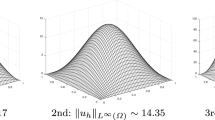In a Hilbert space defined as the image of a unit ball under the action of a compact operator, we solve the problems of optimal recovery of elements according to their first n Fourier coefficients known with errors. Similar problems are also solved for the scalar products of elements from two different classes.
Similar content being viewed by others
References
C. A. Micchelli and T. J. Rivlin, “A survey of optimal recovery,” in: Optimal Estimation in Approximation Theory, Plenum Press, New York (1977), pp. 1–54.
A. A. Melkman and C. A. Micchelli, “Optimal estimation of linear operators in Hilbert spaces from inaccurate data,” SIAM J. Numer. Anal., 16, No. 1, 87–105 (1979).
C. A. Micchelli and T. J. Rivlin, “Lectures on optimal recovery,” in: Numerical Analysis, Springer, Berlin (1984), pp. 21–93.
C. A. Micchelli, “Optimal estimation of linear operators in Hilbert spaces from inaccurate data: a second look,” Numer. Algorithms, 5, 375–390 (1993).
L. Plaskota, Noisy Information and Computational Complexity, Cambridge Univ. Press, Cambridge (1996).
G. G. Magaril-Il’yaev and K. Yu. Osipenko, “Optimal recovery of functions and their derivatives on the basis of their Fourier coefficients given with errors,” Mat. Sb., 193, No. 3, 79–100 (2002).
V. F. Babenko, “On the best use of linear functionals for the approximation of bilinear functionals,” in: Investigation of the Modern Problems of Summation and Approximation of Functions and Their Applications [in Russian], Dnepropetrovsk (1979), pp. 3–5.
V. F. Babenko, Extreme Problems of the Approximation Theory and Nonsymmetric Norms [in Russian], Doctoral-Degree Thesis (Physics and Mathematics), Dnepropetrovsk (1987).
V. F. Babenko, “Approximate computation of scalar products,” Ukr. Mat. Zh., 40, No. 1, 15–21 (1988); English translation: Ukr. Math. J., 40, No. 1, 11–16 (1988).
V. F. Babenko and A. A. Rudenko, “Optimal reconstruction of convolutions and scalar products of functions from various classes,” Ukr. Mat. Zh., 43, No. 10, 1305–1310 (1991); English translation: Ukr. Math. J., 43, No. 10, 1214–1219 (1991).
V. F. Babenko and A. A. Rudenko, “On the optimal renewal of bilinear functionals in linear normed spaces,” Ukr. Mat. Zh., 49, No. 6, 828–831 (1997); English translation: Ukr. Math. J., 49, No. 6, 925–929 (1997).
V. F. Babenko, M. S. Hun’ko, and A. A. Rudenko, “On the optimal recovery of bilinear functionals by the linear information,” Visn. Dnipropetr. Univ., Mat., Issue 17, 11–17 (2012).
I. M. Gelfand and N. Ya. Vilenkin, Some Applications of Harmonic Analysis. Generalized Hilbert Spaces (Generalized Functions, Issue 4) [in Russian], Fizmatgiz, Moscow (1961).
Author information
Authors and Affiliations
Corresponding author
Additional information
Translated from Ukrains’kyi Matematychnyi Zhurnal, Vol. 72, No. 6, pp. 736–750, June, 2020. Ukrainian DOI: 10.37863/umzh.v72i6.1107.
Rights and permissions
About this article
Cite this article
Babenko, V.F., Gunko, M.S. & Parfinovych, N.V. Optimal Recovery of Elements of a Hilbert Space and their Scalar Products According to the Fourier Coefficients Known with Errors. Ukr Math J 72, 853–870 (2020). https://doi.org/10.1007/s11253-020-01828-4
Received:
Published:
Issue Date:
DOI: https://doi.org/10.1007/s11253-020-01828-4



